4 Effective Therapies For Pain Relief
They say that sitting is the new smoking and 80%1 of Americans are living that sedentary desk life.
That lifestyle has the trusty companion of chronic neck pain, back pain, and frequent headaches. In fact, the National Health Interview Survey (NHIS) data reports that 1 in 5 U.S. adults experience chronic pain2.
That’s a lot of people! And if you are one of those chronic desk life with chronic pain sufferers, this article’s especially for you.

Healing modalities that don’t require the use of pharmaceuticals or NSAIDS (aka ibuprofen) are really the ideal option. Pharmaceuticals just aren’t a healthy long-term solution to chronic problems, and neither are invasive surgeries that have a notoriously low success rate.
So what are the best, most affordable, effective and natural options available?
These 4 manual modalities we are presenting are absent of the “woo woo” and “fluff” out there. They are backed by science, not anecdotes. So no smoke and mirrors, and no selling of snake oil here.
Some of these modalities have been around for hundreds of years and are still in use today (and for good reasons). This is because they are manual therapies and it will become fairly obvious as to why they work, once we explain how they do what they do.
When muscles and tendons are manually manipulated, they can loosen, which creates more space for movement and fluid in the joints. With more range of motion, the flexibility in the muscles increases as well. With these types of tissues opening up, there is an increase in blood flow to them, bringing fresh oxygen and nutrients.
The most significant piece in regards to manual therapies is that they increase the movement of the blood and lymphatic system. These two systems are the great healers of soft tissue, connective tissue, and the central nervous system in the body. Blood flow, specifically, to any area of the body will remove toxins and add nourishment.
These 4 modalities will create flow in the circulation systems. The systems will “detox” and create an environment for healing, and we found some blood-moving-goodies for you! So let’s break them down:
GuaSha
GuaSha is an ancient Chinese method used to manually stimulate the treatment of a specific area with a smooth handheld tool. Practitioners of Gua Sha put oil on your skin and vigorously scrape the skin with the tool. They focus on a problem area in order to create more blood flow for detoxification and healing.
If your pain is nerve-related, this technique isn’t going to cut it. It is most often used by massage therapists and acupuncturists nowadays and can be really effective on muscles and tendons.
Seeing a GuaSha technician for treatment will probably cost you between $50 and $100 per session.
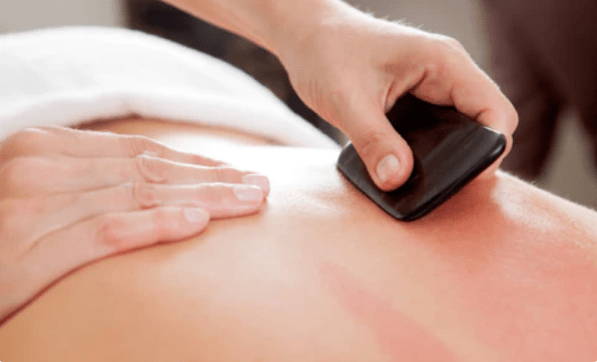
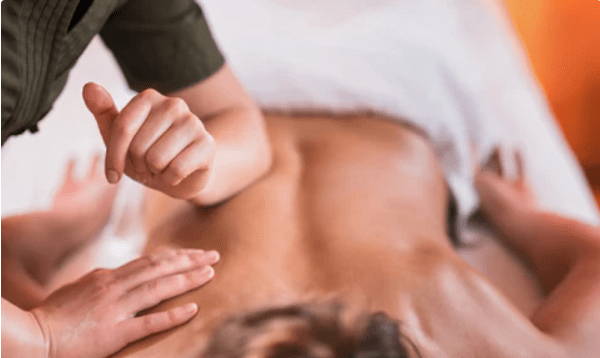
Massage Therapy
Massage Therapy isn’t uncommon nor unknown nowadays. You can find massage therapists in most cities. Massages do tend to be on the higher end, in terms of cost, for getting a treatment.
What massage therapists do in a nutshell: they use manual manipulation of soft tissue with their hands, forearms, and elbows in order to release muscle and tendon tension.
Massage just simply helps muscles relax and open into positions that they are not habituated into. Pressure and oils are the primary movers of the blood and lymph in this type of treatment. Essential oils can be added for anti-inflammatory effects and often hot stones are available to add heat. You can have deep work or Swedish-style pressure, it really depends on what is needed.
Massage is especially good for people with kyphosis, forward head posture, low back pain, or any kind of postural issues, related to long hours at a computer. A lot of computer-related chronic pain is due to repetition and overuse of muscles and tendons.
When our bodies become habituated to slouching, for example, we over-use our back muscles (the rhomboids and upper traps), which can become very tense and hard. And at the same time, our tiny little pec minor muscles will become very tight, pulling our shoulders forward so they look “rounded”. We will get adhesions in these areas (often near the scapula) which people refer to as “knots”.
Neck work from a massage therapist can be of great value to people who suffer from headaches that are caused by neck and head strain or tension.
Massage Therapists are trained in the musculoskeletal system. They also know the anatomy and physiology of how the body moves and how it is connected to nerve pain. Depending on the depth of work you want, massages can be very enjoyable and very effective for chronic tension in the muscles. But if your issue is specifically nerve-related, you might seek help elsewhere.
Massages cost between $80 and $200 a session.
Infrared and Red Light Therapy
Infrared and Red Light Therapies are newer to the market but are a very popular choice for managing body pain. Researchers have known about red light therapy since 1893! A physician named Niels Finsen used red light to treat his lupus clients. A Hungarian physician named Endre Mester also used red light therapy in 1967 while studying how cancer cells react to radiation exposure and accidentally found it had other benefits.
Red light therapy is a procedure used to treat medical and cosmetic conditions. It sends low-intensity, low wavelength red and near-infrared light to stimulate healing. It is non-invasive and painless. It can penetrate through the skin, without damage, to give targeted pain relief within about 10-20 minutes.
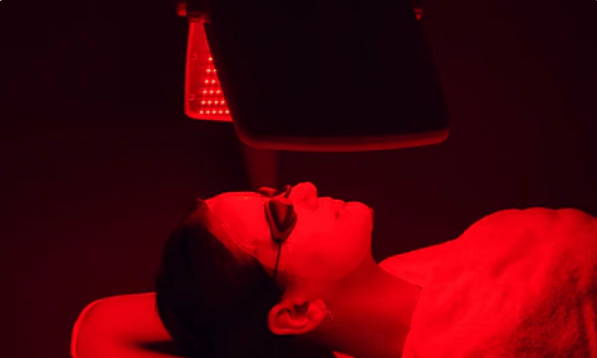
It is scientifically known for helping with carpal tunnel syndrome, psoriasis, tendinitis, osteoarthritis, TMD, and periodontitis.
It is especially good for nerve pain because it can penetrate the skin without irritating nerve cells. It is believed to stimulate the mitochondria of cells which have a variety of important functions for health, healing, and longevity.
Red Light Therapies include infrared saunas (found in high-end spas), and Medical Spas. There are also at-home red light therapy devices that cost anywhere between $500 and $2500.
Red Light Therapy in Med Spas and regular spas will cost between $50 and $150 per treatment.
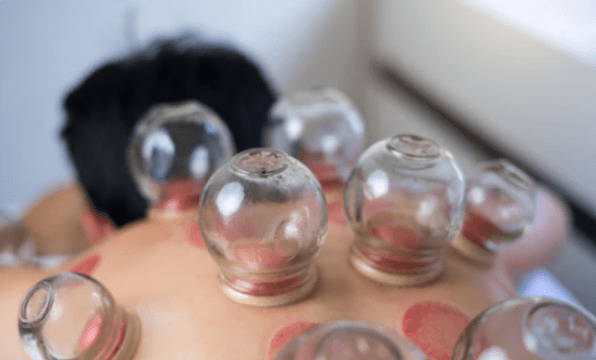
Cupping Therapy
Cupping therapies’ history dates back to ancient eastern cultures. And as a matter of fact, one of the oldest medical textbooks in the world describes how the Egyptians used cupping therapy all the way back in 1550 B.C. Pretty wild.
Cupping therapy is trending these days, although I’d bet it probably still holds some mystique. Let’s break Cupping down into rational terms and we’ll actually give you two options for practicing it.
How it works: Cupping therapy uses flammable substances to heat the inside of a glass cup, then suction it onto the area of the body
that needs to be treated. It’s essentially sucking blood into the affected area for the added benefits of, once again, bringing blood and nutrients to a very targeted spot. Cupping must be done by a trained professional because it can cause bruising or burning if a person is not careful. Traditional Cupping is going to cost between $50 and $80 per session.
Here is a second cupping option:
We've designed this incredible cupping device called the REVO™ Smart Cupping Massager. It's a tool for at-home cupping therapy.
It’s derived from traditional cupping but is enhanced with modern technology, to maximize its impressive list of benefits. It is also safe to use without the help of a professional because it is flame-free and can be adjusted to whatever level of strength you want it at.
REVO™ Therapy is wildly innovative because it includes all three modalities I have already mentioned! Pretty remarkable.
It has a “breathing” technology that suctions and releases rhythmically; creating a cupping effect as well as a massage effect on the treatment area. It is equipped with red and near-
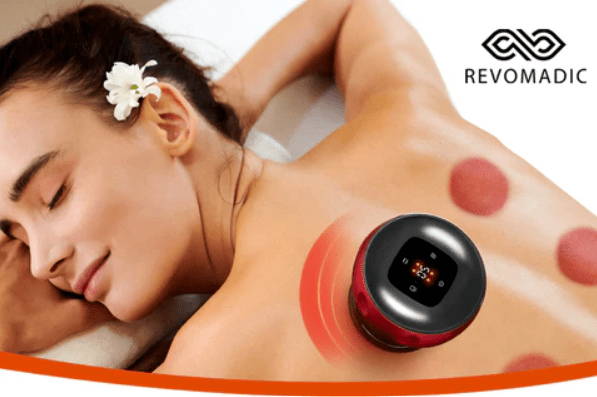
infrared light that penetrates the skin and lastly, it has heating options to warm the targeted area.
So you have red light, heat, and movements, all in one cupping device. You can even include essential oils to your skin while it’s in use, another powerful healing function to add to its arsenal. These multiple healing methods create maximum benefits, including pain relief, improved blood flow, increased mobility, and enhanced recovery. With all of these capabilities, while also being a major convenience to use at home. This device is a big win-win situation. (we are big fans!)
It’s set at a really convenient price of $50, which you only have to pay once.
Conclusion
Finding real solutions to pain relief is critical, as 80.5 million adults in the US alone need it. There are so many options to get our blood flowing and our lymph moving nowadays. Ancient techniques still have value and updated techniques can have even more added value. You really have to figure out what your body needs and what it responds to most effectively. We know that chronic pain can be an all-encompassing experience of absolute misery, so we hope one of these options helps. All of these modalities have proven efficacy in either curing or managing chronic pain (depending on what is damaged). Hopefully, you find one that works for you and your budget and if you can’t afford a professional, at least there is the handy, portable, all-in-one REVO™ Therapy Massager to help you out at home.
References:
Marie, E. (2022, Apr. 2). “Desk Jobs Affect Your Eyesight More Than You Think”
Brigham and Women's Hospital. "One in five American adults experience chronic pain." ScienceDaily. ScienceDaily, 20 April 2021.


